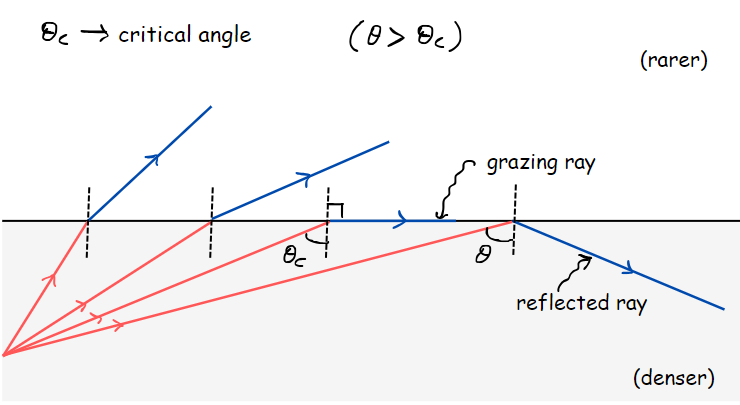Introduction :
Total Internal Reflection also known as TIR is one of the useful phenomenon which has applications in lot of areas. One such example is of Optical Fiber Cables. In this Article, we will be discussing about TIR : What is it ? Under what conditions does it happen ? What is the difference between ‘normal reflection’ and ‘total internal reflection’ ?
Topics Covered :
- What is meant by reflection ?
- How does TIR happen ?
- Difference between normal reflection and TIR
1. What is meant by reflection ?
In simple words, Reflection is nothing but bouncing back of light into the ‘same medium’ once it gets hit onto a polished hard surface (usually mirror).

2. How does Total Internal Reflection happen ?
When a light travels from one medium to another, it bends. But does it bend toward the normal or away from the normal depends on the fact that from which medium to which medium it is going.
- Rarer to Denser – bends towards the normal
- Denser to Rarer – bends away from the normal


Now, this specific case of Total Internal Reflection (TIR) happens when the light travels from denser medium to rarer medium.

From the figure, as we keep increasing the angle of incidence, the angle of refraction also increases until the critical angle is reached.
Critical Angle :
For each medium interface, we have a special angle defined, known as critical angle. In simple words, it is the angle of incidence at which the refracted ray grazes along the medium-separating interface (the angle of refraction becomes 90 deg).

TIR Condition :
When the angle of incidence goes beyond this critical angle, the ray gets ‘reflected back’ into the ‘same medium’. This phenomena is called ‘Total Internal Reflection’
3. Difference between Normal Reflection and TIR :
Normal Reflection :
- The intensity of the incident ray is much greater than the intensity of reflected ray. This is because during normal reflection, a part of the light gets absorbed by the material of which it hits and some of it gets transmitted further.

Total Internal Reflection :
- In this case of the incident ray intensity is retained 100 % by the reflected ray. This is the major differnce between Normal Reflection and Total Internal reflection

A small Question (JEE Advance PYQ) :
Question :
A light ray travelling in glass medium is incident on glass-air interface at an angle of incidence. The reflected (R) and transmitted (T) intensities, both as function of theta, are plotted. The correct sketch is :

Answer : (C) option
- At angle of incidence = 0 deg : Most of the light (not 100%) is transmitted.
- At angle of incidence > critical angle : 100 % of light is reflected and hence 0% transmission of light
FAQ section :
What is Total Internal Reflection (TIR) ?
TIR is the phenomenon in which the incident light travelling from denser medium to rarer medium gets reflected back into the denser medium retaining its full intensity (100%).
We call an refracted ray as a grazing ray when it passes along the interface separating two mediums
What is meant by critical angle in TIR ?
For each medium interface, we have a special angle defined, known as critical angle. In simple words, it is the angle of incidence at which the refracted ray grazes along the medium-separating interface (the angle of refraction becomes 90 deg).
Students from class 10, class 11, class 12 preparing for boards or competitive exams like JEE, NEET, etc. or someone just having interest in Physics can refer to this article
Under which chapter, does this topic come ?
This topic of Total Internal Reflection or TIR comes under the ‘Ray Optics’ Chapter, also known as ‘Geometrical Optics’
What are the main concepts needed to study this ?
Reflection and Refraction (applying Snell’s Law) are the two important concepts needed


